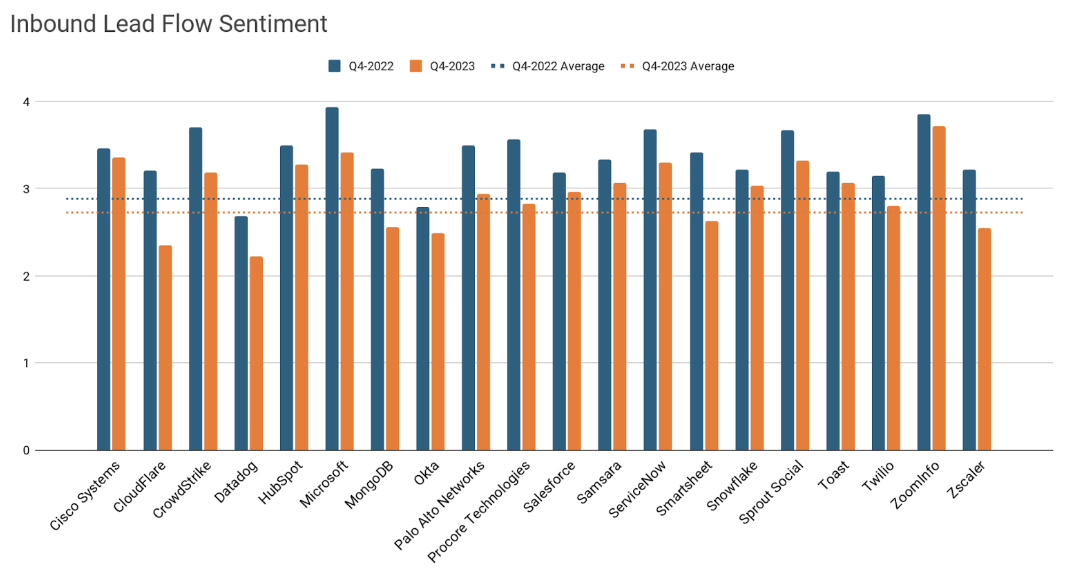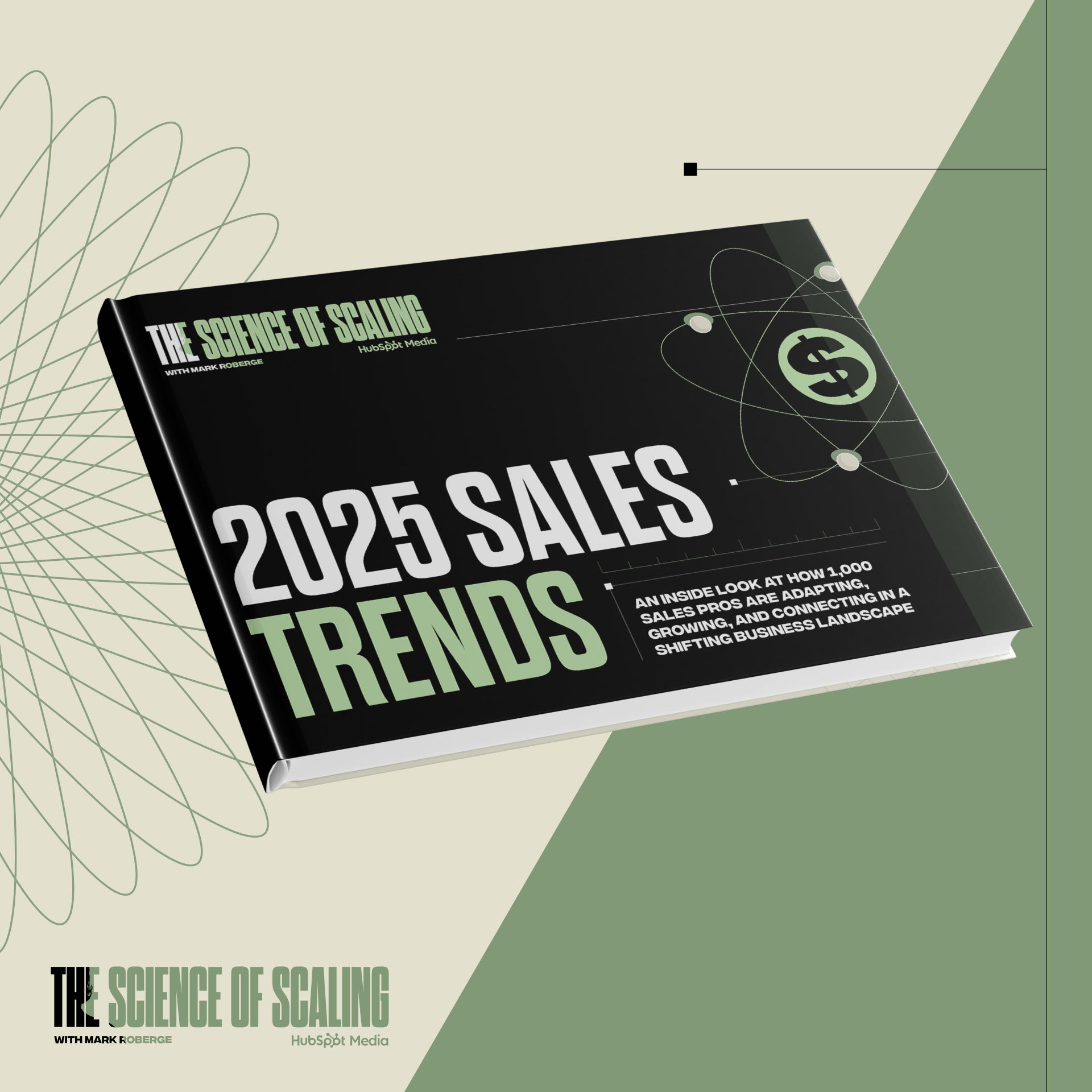Every seller wants a strong, steady stream of quality inbound leads. Preferably ones with a big budget and high intent to purchase. Lately, that’s unlikely to be the case.
So, let’s take a look at the trends sellers are reporting about inbound lead flow on RepVue, and three things you can do to still hit your targets.
Seller Sentiments About Inbound Lead Flow Fell Year-Over-Year
Here’s some data we were looking at recently that shows the difference in seller sentiments for inbound lead flow comparing Q4-2023 to Q4-2022.
When salespeople rate their sales organizations on our site, we ask them to rate how they feel about inbound lead flow on a scale from 1–5.

20 different sales orgs. Some companies with explosive growth over the past few years. Some B2B tech giants who’ve seen success for a decade or more.
Salespeople said inbound lead flow was worse than it was a year before at every one of these companies And directly or indirectly related, quota attainment rates were down year-over-year, as well.
What It Means for Sales Reps
So, what exactly does that mean for you? It means sales and go-to-market motions are going to have to evolve. (Marketing is going to have to evolve, too, but that's a whole other topic.)
We all know buyer research is changing. Buyers are more informed and empowered than ever before. They have access to a wealth of information online, from product reviews and customer feedback to detailed product specifications and pricing information.
So as a result, they are able to conduct much of their research independently, without the need for direct contact with sales reps or other employees at those companies. Fewer prospects are going to just hit your lead form in 2024. Don’t count on a lot of interest in those 45-minute webinars. (And don’t consider everyone who does sign up a hot lead!)
This has probably come as a bit of a shock to any sellers who started their careers in the late 2010s. Budgets were inflated and inbound leads were plentiful, which created a distorted view of what it’s like to sell.
That’s all changed now. One thing that isn’t going to change, though, are your sales targets.
3 Things Sellers Can Do to Hit Their Numbers
Chief Revenue Officers, VPs of Sales and the rest of sales and marketing leadership are undoubtedly building new playbooks to address the change over the long-term. In the short-term, there are things you as a seller can do, too.
These won’t be a surprise to more seasoned reps. But if you started in sales in the last few years — when companies had high budgets and inbound leads were plentiful — these tried-and-true tactics may be new to you.
1. Boosting Active Prospecting, Outbound Efforts, and Social Selling
Inbound leads are not the only way to generate new business. Active prospecting and outbound efforts are still effective. You’ll have to put in more effort up front, but it’s going to be an important way to make up for a lack of inbound leads.
Don’t just spray-and-pray. Cold-emailing the same message to every email address you can find won’t be effective. You have to do your research to identify potential prospects. And you have to thoroughly understand their needs and pain points. If you don’t, you’ll be (rightfully) ignored.
Then, personalize your outreach to each prospect to make it more relevant and engaging. Skip the cookie-cutter opening about “being a big fan” of your prospect’s company or product. Go deeper. Find something relevant to the solution you have to offer in a recent press release or earnings report, or possibly their personal interests or history.
Finally, use a multichannel approach to reach prospects where they are. Email, LinkedIn messages, phone calls — mix it up.
Social selling is a newer approach that is quickly moving from the experimental category to a key strategy for success. By putting helpful content in front of potential prospects on social channels, you can establish yourself in their minds as an expert on a particular solution.
This can be a great way to begin building a relationship. They may reach out to you. If not, when you reach out to them, they’ll already “know” you to some extent and be more likely to engage.
Don’t just set up a two-week email cadence in your sales automation platform and call it a day.
2. Mining the CRM for Your Ideal Customer Profile List
The CRM is an untapped goldmine for a lot of organizations. There are more prospects that fit your ICP in your CRM than you probably realize. When was the last time you went digging?
An opportunity from years ago who chose to go with your competitor. Check in around the renewal date to see if they’re still happy with their choice. That prospect who ghosted you when you were sure they would close last quarter? Reach back out to see if now’s a better time to implement your product or service to solve their challenges.
The abundance of leads who weren’t in your ICP when they originally reached out? Maybe they’ve grown and have a larger budget now, or they’ve changed their business model in a way that better fits your solution.
Closed-lost is “not now”, not necessarily a no forever.
3. Maximizing the Value of Existing Customers
Finally, don’t forget about maximizing the value of your existing customers in every way you can.
When was the last time you discussed how their needs or challenges have changed? You don’t need new leads to upsells or cross-selling to your existing customers. And they’re most likely looking for ways to thrive in a challenging sales environment just like you are. Find ways to make it easier for them.
You should also talk to your existing customers to get referrals and recommendations to their network. Ask your clients if they know anyone who’d be interested in what you have to offer. Even better, ask about someone in their network who you think would benefit from your products or services. A customer who loves you and your solution will be happy to make an introduction.
Success Comes from Agility and Adaptability
You’re probably going to have fewer inbound leads this year, and that will mean you need to adjust your strategies to be more proactive. But that’s part of the challenge and excitement of sales.
Sellers who are agile and quick to adapt will hit their numbers in the short-term — and will likely have sustainable success as the strategies required evolve throughout their careers. Good luck out there!
Lead Generation






.jpg)


.jpg)


